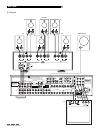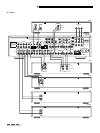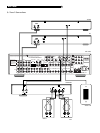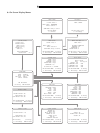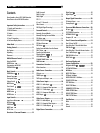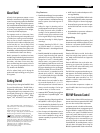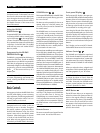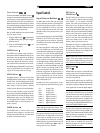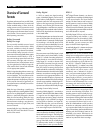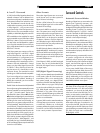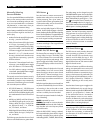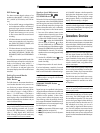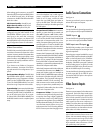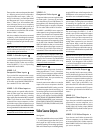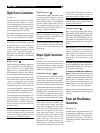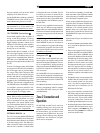
14
Overview of Surround
Formats
To get best performance from your RSP-1066,
it helps to understand the many surround sound
formats available today, to know which de-
coding process to use for a particular record-
ing, and how to select it. This section provides
basic background information about surround
sound formats. The next sections provide de-
tailed operating instructions.
Dolby Surround
Dolby Pro Logic
The most widely available surround sound
format for consumer audio/video is Dolby
Surround
®
, available on nearly all commer-
cial VHS tapes, many television broadcasts,
and most DVDs. Dolby Surround is the con-
sumer version of the analog Dolby Stereo system
first introduced in the film industry in 1972. It
is a matrix-encoding system that records front
left, front center, front right, and a mono sur-
round channel into a 2-channel stereo record-
ing. During playback, a Dolby Pro Logic
®
de-
coder extracts each channel and distributes
it to the appropriate speakers.
Dolby Pro Logic decoding delivers a mono sig-
nal with reduced high-frequency content to the
surround speakers. The more advanced de-
coder in the RSP-1066, Dolby Pro Logic II, in-
creases the separation and frequency response
of the surround channels for significantly im-
proved performance with Dolby Surround en-
coded recordings.
Dolby Pro Logic II decoding is used for any
analog soundtrack or recording labeled “Dolby
Surround” or any Dolby Digital 2.0 soundtrack.
While it is specifically designed to decode
Dolby Surround recordings, Dolby Pro Logic
can derive surround sound from conventional
2-channel stereo recordings, using phase re-
lationships to extract front, right, center, and
surround channels.
Activate Dolby Pro Logic II decoding with the
Dolby PLII/3ST button described in the next
section of the manual.
Dolby Digital
In 1992, an entirely new digital recording
system, called Dolby Digital, was first used in
the film industry. Dolby Digital is a recording/
playback system that uses compression tech-
niques to store large amounts of audio data
efficiently, much like the JPEG format stores
large photographs in small files on a computer.
Dolby Digital is the standard audio format for
DVDs and for digital television broadcasting
in the United States.
The Dolby Digital system can be used to record
up to six discrete audio channels, but can con
be used for fewer. For example, a Dolby Digital
2.0 recording is a 2-channel stereo record-
ing such as a matrix encoded Dolby Surround
soundtrack. To play this type of recording, use
Dolby Pro Logic II decoding as previously de-
scribed.
The most common use of Dolby Digital, in both
the film industry and in home theater, is Dolby
Digital 5.1. Instead of encoding multiple sur-
round channels on a two-channel recording,
Dolby Digital 5.1 records six discrete chan-
nels: front left, front center, front right, surround
left, surround right, and a Low Frequency Ef-
fects (LFE) channel containing ultra-low bass
signals intended for a subwoofer. A Dolby Digi-
tal decoder extracts the channels from the digital
bitstream, converts them to analog signals and
routes them to the appropriate speakers. All
channels provide full frequency response with
total separation between all channels and large
dynamic range capability. A Dolby Digital 5.1
soundtrack will provide significantly more
impressive surround sound than Dolby Pro Logic
decoding of matrix Dolby Surround.
Decoding of Dolby Digital 5.1 soundtracks is
automatic. When the RSP-1066 detects a Dolby
5.1 signal on one of its digital inputs, it acti-
vates the proper processing. Keep in mind that
Dolby Digital is only available from digital
sources (a DVD, a LaserDisc, or a Digital TV/
Cable/SAT tuner). Also, you must connect the
source with a digital cable (coax or optical)
to an active digital input on the RSP-1066.
NOTE
: Many DVDs have a Dolby Digital 2.0
matrix soundtrack as the default, which should
be decoded with Pro Logic II. The Dolby Digi-
tal 5.1 soundtrack may have to be selected
as an option from the setup menus at the be-
ginning of the DVD. Look for a Dolby Digital
5.1 selection under “Audio” or “Languages”
or “Setup Options” when you insert the disc.
DTS
5.1
DTS
®
(Digital Theater Systems) is an alterna-
tive digital format competing with Dolby Digital
in both movie theaters and home theater
markets. The basic features and functions of
the DTS system are similar to those of Dolby
Digital (for example, 5.1 discrete channels),
however the technical details of the compres-
sion and decoding processes differ somewhat
and a DTS decoder is required.
Like Dolby Digital, DTS can only be used on
a digital recording and, therefore, is only
available for home use on LaserDiscs, DVDs,
or other digital formats. To use the RSP-1066’s
DTS decoder, you must connect your DVD
player to the RSP-1066’s digital inputs.
As with Dolby Digital 5.1, detection and proper
decoding of DTS 5.1 signals is automatic.
NOTE
: DVDs with a DTS soundtrack almost
always have it configured as an option to the
standard matrix Dolby Surround format. To
use DTS, you may have to go to the setup
menus at the beginning of the DVD and se-
lect “DTS 5.1” instead of “Dolby Surround”
or “Dolby Digital 5.1”. In addition, many DVD
players have the DTS digital bitstream turned
off by default and cannot output a DTS
soundtrack, even if selected on the disc’s
menu, until you activate the player’s DTS out-
put. If you here no sound the first time you
attempt to play a DTS disc, you may have to
go to the DVD player’s configuration menus
and turn on the DTS bitstream. This is a one-
time setting and need only be done once.
See your DVD owners manual for details.
The RSP-1066 features a second type of DTS
surround sound decoding: DTS Neo:6. This
decoding system is similar to Dolby Pro Logic
II in that it is designed for playback of any 2-
channel stereo recording, either matrix-encoded
or not. The Neo:6 decoder can by used with
any conventional 2-channel source such a
stereo TV or FM broadcast or a CD. It can also
be used as an alternative method of decod-
ing matrix-encoded Dolby Surround record-
ings or TV broadcasts. Activate the DTS Neo:6
decoding with the DTS:Neo 6 button as de-
tailed later in this section. DTS Neo:6 is not
used with DTS 5.1 digital sources and the button
need not be pressed for those recordings.
RSP-1066 Surround Sound Processor



